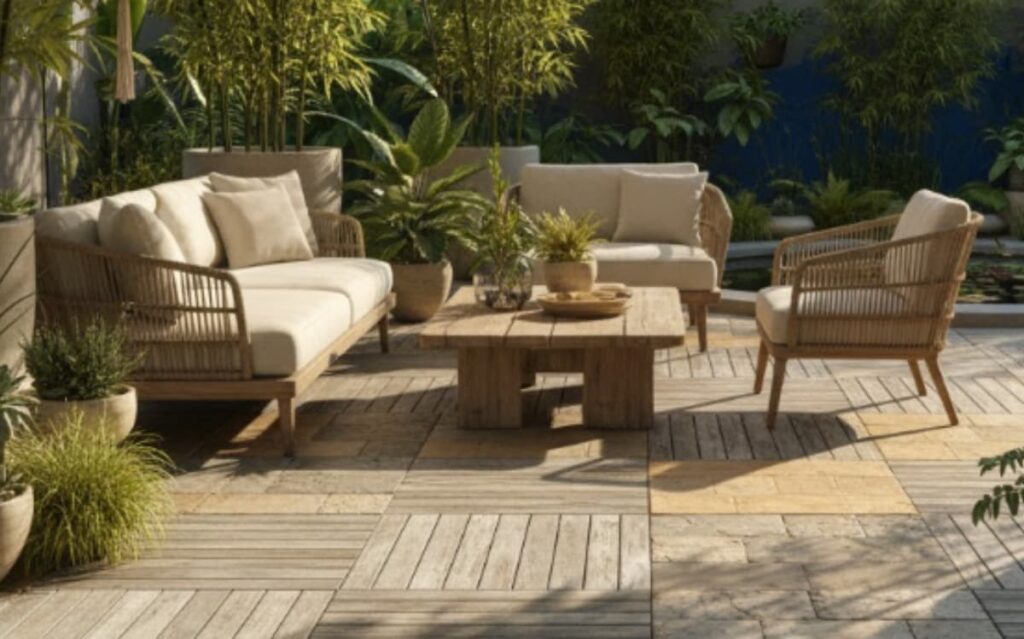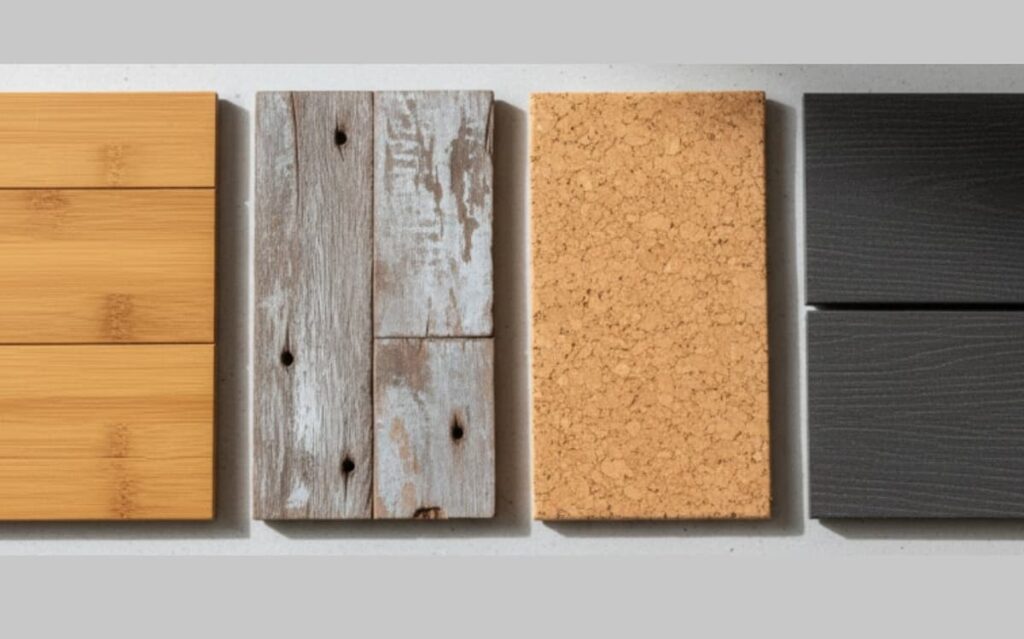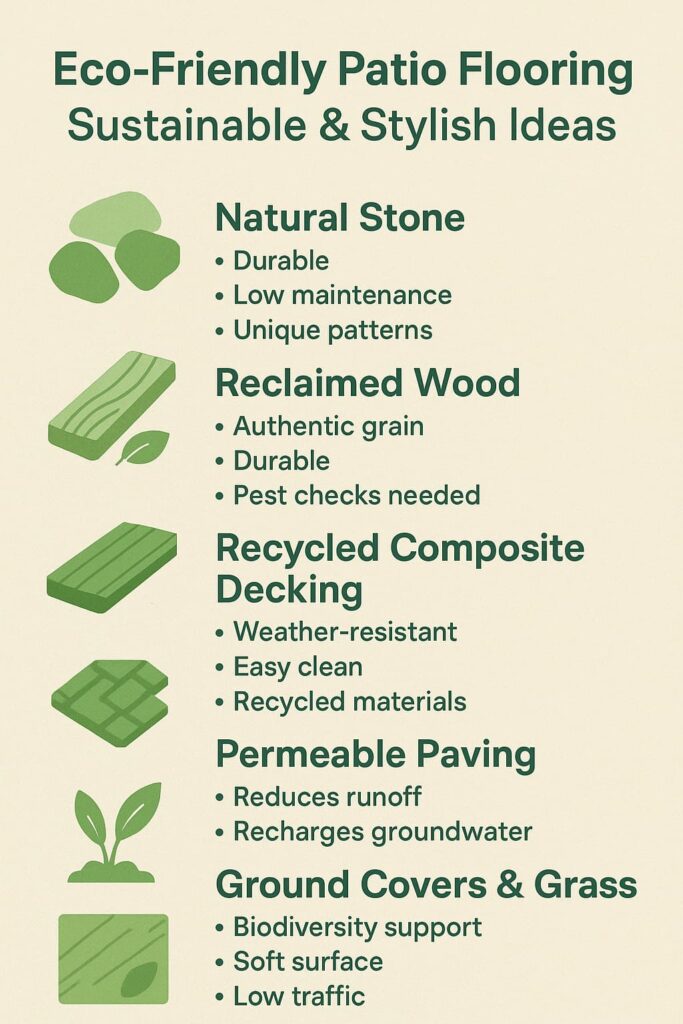Explore top eco-friendly patio flooring ideas. Discover sustainable options like natural stone, reclaimed wood, recycled composites, and permeable pavers for a stylish yard.
Building a proper patio shouldn’t mean destroying nature in the process. The old concrete slab approach leaves a lot to be desired, cracking in winter, baking in summer, and sending rainwater straight into storm drains. Better options exist right in our backyards.
Reclaimed barn wood brings decades of character straight to outdoor spaces. Local quarry stone shows off natural patterns and fossil marks you’d never find in mass-produced materials.
Even those permeable pavers that look fancy serve a real purpose, letting rain soak into gardens instead of running off into gutters.
Keep reading to find out more about eco-friendly patio flooring.
Key Takeaways
- Stone from nearby quarries cuts transport costs and diesel fumes
- Salvaged wood keeps historic materials working instead of rotting in dumps
- Proper drainage through permeable surfaces means healthier soil and fewer puddles
Natural Stone: Durable & Timeless Aesthetics
Walk through any historic garden and you’ll spot stone paths that have stood strong for generations. Raw stone like slate, limestone, and granite doesn’t just look good, it stays good, year after year, rain or shine.
Getting stone from quarries close to home makes sense. Less trucking means less pollution, plus the stone matches what’s already in the area. These stones might cost more upfront, but they’ll be around longer than most houses.
Mix and match different stones to create something unique. Rough flagstone makes great walking paths, while smooth granite or slate works better for sitting areas. The variety of options makes stone one of the most versatile types of outdoor flooring for patios. The natural marks and colors in each piece add something special that factory-made materials just can’t match.
Here’s what makes stone worth considering:
- Built to last: Stone handles whatever nature throws at it, hot summers, icy winters, and kids running around
- Low maintenance: A quick sweep now and then keeps it looking fresh, maybe a wash once a year
- Natural good looks: Each piece has its own pattern and color, no two patios ever look exactly alike
But before picking stone, think about:
- Higher price tag: Digging it up and cutting it takes work, which shows in the cost
- Extra protection needed: Softer stones like limestone need sealing every few years to stop water damage
Reclaimed Wood Decking: Old Timber, New Life

There’s something about walking on century-old wood. These timbers, salvaged from old barns and factories, bring real grit to backyard spaces that boxstore lumber can’t match.
According to the EPA, Americans dumped around 600 million tons of construction waste in 2018 [1]. Instead of rotting in dumps, these boards deserve better. The scratches, holes, and marks aren’t problems, they’re proof of time well spent.
The wood’s got stories to tell. Nail holes from the 1900s. Marks from old machinery. Colors that only decades of sun can create. And surprisingly, these old boards often stand up better than new ones, tight grain patterns from slower tree growth back then.
What you get:
- Real age marks: Can’t fake those decades of wear
- Tough stuff: Dense grain from old-growth trees
- Different every time: No cookie-cutter patterns here
Watch out for:
- More work: Old wood needs extra TLC
- Bug check: Keep an eye out for unwanted guests
- Cost: Quality salvaged wood isn’t cheap
Yeah, it’s more hassle than grabbing fresh planks. But that’s the point. A reclaimed wood deck doesn’t just look lived-in, it actually was. Once the deck is complete, its unique character provides the perfect foundation for some of the best outdoor patio furniture sets to create a cohesive living space.
Recycled Composite Decking: Built Tough, Earth-Smart
Take sawdust and plastic trash, mix them up smart, and you’ve got composite decking. It’s not rocket science, just old junk getting a new job. Milk jugs, grocery bags, wood chips that nobody wants, they all end up in these boards instead of piling up somewhere useless.
These things last forever (okay, more like 25+ years, but who’s counting?). No splinters in your feet. No yearly painting headaches. Just solid decking that handles whatever nature throws at it.
Sure beats traditional wood sometimes. Pool parties? No problem, this stuff won’t get slippery, making it a top contender when choosing the best outdoor flooring for patios near water. Dinner outside? Spill that wine, it’ll clean right up. And forget about those yearly maintenance weekends, a quick spray with the hose usually does the trick.
What’s good:
- Tough as nails: Won’t rot, crack, or fall apart
- Lazy-proof: Skip the sanding and staining drama
- Looks decent: Comes in colors that actually look like wood
- Clean-up’s easy: Soap and water usually handle it
Watch for:
- Fake vibes: Yeah, it’s not real wood, you can tell up close
- Plastic stuff: It’s recycled, but won’t break down naturally
- Gets hot: Dark colors especially can cook your feet in summer
It’s not trying to be fancy, just practical. Like those old work boots that never wear out, composite decking just keeps showing up, doing its job, year after year.
Recycled Rubber Flooring: From Road to Yard

Old tires don’t have to die in landfills. Dissamble them, and they make some pretty solid outdoor flooring. Each year, thousands of worn-out tires skip the dump and end up under feet instead.
This stuff’s like a tank, handles hot sun, freezing cold, and doesn’t crack when the weather gets weird. Rain? No problem. The texture keeps people from slipping around like they’re on ice. Plus, it’s got some give to it, way better than concrete if someone takes a tumble.
Not stuck with basic black anymore either. These days rubber flooring comes in colors that actually look decent. Works great for:
- Play areas: Kids bounce off it instead of getting scraped up
- Garden paths: Feet don’t ache after weeding
- Workout spots: Drops weights? No cracked concrete
Things to think about:
- New rubber smell: Takes a few weeks to fade
- Looks different: Won’t fool anyone into thinking it’s fancy stone
- Sun fading: Dark colors might lighten up over time
- Heat: Gets warm in direct sun, but not as bad as pavement
Skip the pressure washer though, regular hose-downs keep it clean. Might not be aesthetic, but it gets the job done without fuss. Perfect for spots where function beats aesthetics.
Permeable Paving: Water-Conserving Solutions

Permeable paving systems are designed to allow water to pass through the surface and seep into the ground beneath, rather than running off into storm drains. This category includes materials like porous concrete, permeable block pavers, and gravel.
By mimicking the natural process of water absorption, these solutions help manage stormwater, reduce flooding, and replenish underground aquifers.
Research has shown that permeable pavements can be highly effective, with some studies indicating they can reduce runoff by as much as 98% compared to standard asphalt. [2]
This makes them an excellent choice for creating an environmentally responsible and resilient landscape. We can integrate this functionality into many areas of our landscape, such as using permeable pavers for driveways or creating attractive walkways with gravel that also help manage rainwater.
Permeable systems offer significant ecological advantages that contribute to a more sustainable and resilient property and community.
- Minimizes erosion: By slowing down and absorbing rainwater, permeable paving helps to prevent soil erosion on our property and in the wider landscape.
- Prevents flooding: These systems can significantly reduce the risk of localized flooding during heavy rain events by managing water at its source.
- Eco-friendly: They support a healthier ecosystem by filtering pollutants and maintaining natural water cycles.
We need to consider the installation requirements and long-term care needed to ensure these systems function correctly.
- Can be more expensive to install: Permeable systems require a carefully prepared sub-base of aggregate layers, which can increase the initial installation cost.
- Requires proper maintenance: The surface needs to be kept free of fine sediment and debris to prevent the pores from clogging, which can be done with regular sweeping or occasional vacuuming.
Ground Covers and Grass: Natural & Biodiverse
Using living plants like native ground covers and grass is a truly natural and eco-friendly approach to creating a patio or pathway. Instead of hardscaping, we can cultivate a “green” surface that is both beautiful and beneficial to the local ecosystem.
Options can range from a traditional lawn to low-growing, resilient ground covers like creeping thyme or native mosses. This method turns our outdoor floor into a living part of the garden, actively contributing to the environment by promoting local flora and supporting pollinators like bees and butterflies.
These plants also help purify the air by absorbing carbon dioxide. Once established, many native ground covers are drought-tolerant and require little care. However, this option is not suitable for high-traffic areas, as heavy use can damage the plants.
We can integrate living ground covers creatively, such as by planting them between stepping stones to create a fragrant path or using them for a low-use patio intended for quiet relaxation.
Porcelain and WPC: Tough Stuff, Clean Look
Porcelain pavers pack natural clay into something that’ll outlast most decks. Fire it up hot enough, and you get tiles tough as nails that don’t soak up spills. Meanwhile, WPC mixes wood bits with plastic (mostly recycled junk) into boards that handle whatever you throw at them.
Neither one’s going to rot away anytime soon. Pretty handy when you’re sick of replacing worn-out decking every few years. They nail that sleek, modern look too, porcelain for those crisp, clean patios, WPC for decks that don’t scream “plastic!”
Nice stuff about these:
- Look sharp: Clean lines, cool colors, zero fuss
- Built to last: Skip the yearly fix-up routine
- Rain or shine: Weather just rolls right off
- Decent green cred: Less waste, fewer replacements
Keep in mind:
- Costs more upfront: It costs more than standard quality
- WPC’s got plastic: It’s recycled, but won’t break down
- Installation’s fussy: Get it wrong, you’ll know it
- Can look too perfect: Some people want that worn-in feel
Bottom line, they’re not trying to be wood. They’re doing their own thing, and they’re pretty good at it. Just don’t expect that classic timber charm.
Choosing the Right Eco-Friendly Flooring
Selecting the right eco-friendly patio flooring involves balancing our priorities for sustainability, style, and practicality. Each material offers a unique set of benefits, from the timeless durability of natural stone and the repurposed charm of reclaimed wood to the low-maintenance innovation of recycled composites.
By carefully considering the environmental impact, aesthetic appeal, and long-term performance, we can create a beautiful outdoor space that we can feel good about.
Making this conscious choice allows us to enjoy our patio knowing we have made a responsible contribution to the environment. If you are ready to transform your outdoor space with a beautiful and sustainable patio, our team is here to help you navigate the options and bring your vision to life.
To discuss your project and get expert guidance, please contact us at Lapis Patios.
References
- https://www.epa.gov/facts-and-figures-about-materials-waste-and-recycling/construction-and-demolition-debris-material
- https://watermanagement.ucdavis.edu/application/files/5414/3891/2393/A03_Terhell_Cai_Chiu_Murphy_ESM121_FinalReport.pdf
